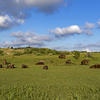Milestone: 10 years of bison in Dutch nature
On April 24 2017 it is exactly ten years ago that the first European bison project in Dutch nature started. Three bison made their very first steps in dune area Kraansvlak near Zandvoort. The goal? Gain experiences with natural grazing of bison in Dutch nature.
Unique in comparison to other European nature areas where bison are present, is that the animals in Kraansvlak are not supplementary fed and live in a heterogeneous landscape not dominated by forests. From the start of the project research is taking place, now ten years later much valuable scientific as well as practical knowledge has been gained.
European bison brings natural richness
Kraansvlak - a dune area in National Park Zuid-Kennemerland - was treathened by grass and shrub encroachment early 2000. The natural richness of the landscape was about to decrease. A monotone area harbours a less varied range of plant and animal species compared to a varied landscape that contains open grasslands, shhrubberies and trees. The European bison, Europe's largest terrestrial animal, was known for its preference for grasses and woody vegetation. It made the species the ideal candidate to combat the encroachment of the area together with present species fallow deer, roe deer and rabbit. Ten years after the arrival of the bison we indeed see the landscape became more varied. Shrubberies with spindle tree and sea buckthorn have decreased or opened up. More flowerrich grasslands and herbs have popped up. In addition, the bison are fond of wallowing and the used sandy patches are the ideal habitat for solitary bees. The patches are connected by sandy paths that in turn are used by sand lizards. The varied landscape is beneficial for species such as seaside pansy of which butterflies like Queen of Spain fritillary profit.
Meanwhile, alongside bison and roe deer plus fallow deer also konik horses and Highland cattle live in Kraansvlak. This herbivore species assemblage in one area is unique.
Bison and recreationist in one area
Besides ecological knowledge, project partners ARK Nature and PWN aimed to learn from the combination of recreation with bison. Back then, not much was known about this aspect. Kraansvlak was a closed off area for public. In order to offer hikers a unique nature experience, guided excursions are being organised since 2007. This also gave the opportunity to intensively study the animals during their encounter with public. The data show bison are alert towards human visitors but show calm behaviour. When showing respect to this mighty animals and keep distance (50 m), chances are high to see the animals in their natural behaviour without disturbing them. The popular hiking excursions are meanwhile expanded to photography excursions and horseback excursions. Since 2012 a special hike trail is opened from September to March in the western part of the bison area. The bison has been embraced in the region. Nature lovers from other parts of the country and beyond have been visiting the trail. So far, thousands of people have been enjoying an unique wildlife experience.
Endangered species
Currently there are just over 6,000 European bison throughout Europe, a doubling compared to the year 2000. Still, the European bison is regarded as an endangered species. In partnership with the species Pedigree Book, the Kraansvlak bison project contributes to a brighter future for the species. More space for bison will make a broader (genetic) spread of the animals through the whole of Europe possible. In Kraansvlak so far over 20 calves have been born. We supported other (starting) bison projects by translocating animals to other nature areas. In 2016 a long cherished wish became reality when bison arrived in two other Dutch nature areas: Maashorst and Veluwe.
Ten years of bison: a milestone
Ten years after the start of the bison project in Kraansvlak we celebrate its anniversary. On April 23 we start with public activities in visitor centre De Kennemerduinen in Overveen, where the stuffed founding father of the current herd can be admired. A photo contest for school children starts, as well as a colour contest for adults. In October a national symposium will be held, followed by an international congress. The closure of all activities follows on October 15 during a special public day.
Partners
The bison project started as a partnership of PWN, Stichting Kritisch Bosbeheer, Stichting Duinbehoud, ARK Nature and FREE Nature. In addition we work together with Ekogrön and Rewilding Europe. The project and activities can be followed via Facebook and Twitter. The project has been made possible by Prins Bernhard Cultuurfonds, Provincie Noord-Holland, VSB Fonds and Stichting ANO Fundatie. On a yearly base the project is supported by the Dutch Postcode Lottery via ARK Nature.


